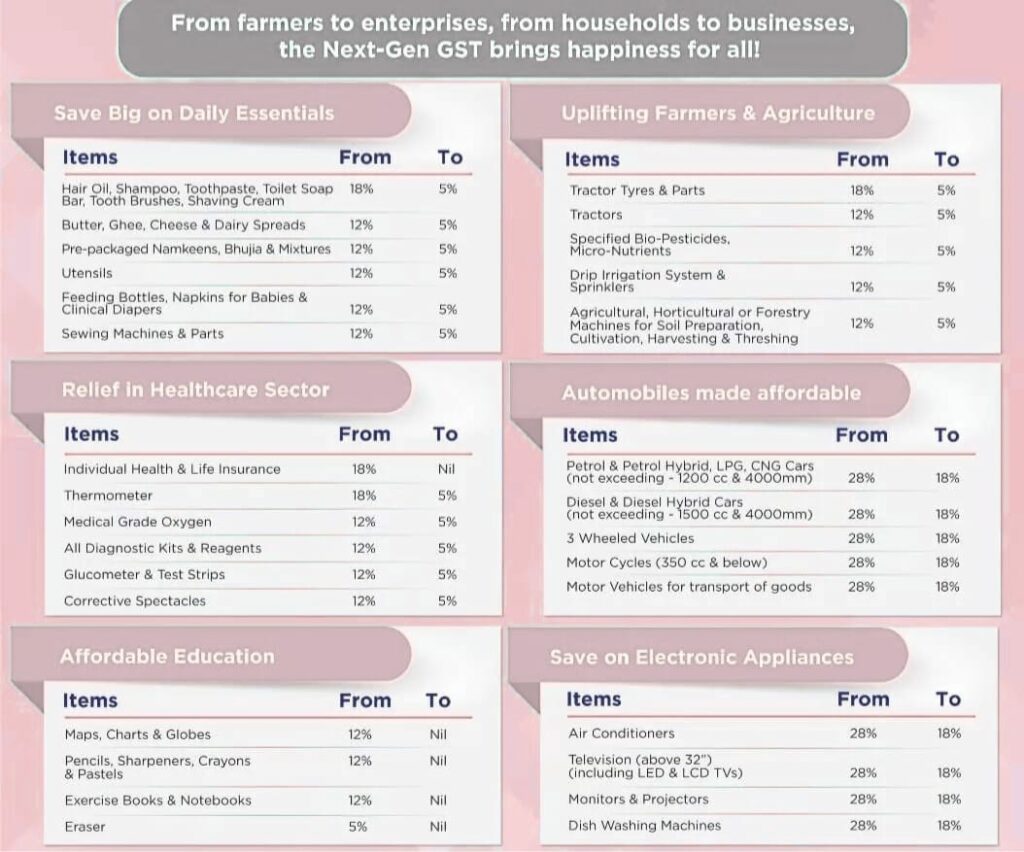In a landmark move aimed at stimulating consumption, simplifying compliance, and providing relief to middle- and lower-income households, the 56th GST Council, led by Finance Minister Nirmala Sitharaman, has approved a sweeping overhaul of the GST structure, being termed as GST 2.0, with changes taking effect from September 22, 2025.

- GST Slabs Rationalized: Two Main Rates + One Luxury Rate
- Simplified Structure
The council has cut down the four-tier GST system to just two primary slabs, 5% and 18%, while introducing a new 40% rate exclusively for luxury and sin goods such as premium automobiles, tobacco products, and pan masala. (Source)
- Wider Benefits for Consumers
Several goods and services, including packaged foods, personal care items, educational tools, and medicines, have seen a shift to the 5% or nil tax bracket, making them more affordable. (Source)
- Luxury Items & Sin Goods Stay Premium
High-value items like cigarettes, alcoholic beverages, and high-end bikes will now attract the 40% GST, with cess components remaining in place until states’ compensation dues are cleared. (Source)
- Sectoral Impacts: Price Drops & Economic Stimulus
- Apparel (e.g., Raymond)
Raymond Lifestyle has announced price reductions for over two-thirds of its product line following a GST cut from 12% to 5% on garments priced below ₹2,500.
- Automobile Sector (Two-Wheelers)
Royal Enfield bikes under 350cc will now be taxed at 18% (down from 28%), while high-end models above 350cc will be taxed at the new 40% rate, targeting luxury consumption.
- Dairy Sector
The dairy industry is expected to gain around ₹11,400 crore due to GST rationalization, helping producers with better margins and end consumers with lower prices.
- Real Estate & Construction
Reductions in GST on cement and building materials aim to reduce overall construction costs, though the pass-through benefits to homebuyers remain at the discretion of developers.
- Insurance Sector Relief Proposal
The Life Insurance Council has urged the government to remove the 18% GST on commissions paid to agents, complementing earlier premium-related GST reliefs.
- Education & Healthcare
Key services like school textbooks, digital education platforms, and primary health services are either fully exempted or moved to the 5% slab, reinforcing social spending goals. (Source)
- GST Compliance Reforms: Tech-Driven Simplification
- Auto Refunds & Prefilled Returns
By October 2025, taxpayers will benefit from automated refund processing and pre-filled returns, aimed at reducing filing errors and delays. (Source)
- Single Registration for E-commerce Sellers
Sellers operating across states via e-commerce platforms will now need only one GST registration, easing barriers to expansion for small and medium businesses. (Source)
- Government’s Vision and Messaging
Finance Minister Nirmala Sitharaman clarified that the move was not politically motivated, but part of a longer-term vision by Prime Minister Modi to reduce the tax burden for the average Indian and empower small businesses.
In her interview with India Today, she stated:
“We are keeping citizens’ relief as the primary goal, not revenue collection. GST 2.0 reflects the government’s pro-consumer and pro-MSME approach.”
Conclusion
The rollout of GST 2.0 marks a pivotal moment in India’s tax landscape. By rationalizing tax slabs, easing compliance, and reducing rates across essential sectors, the government has taken a strong step toward making the GST regime more equitable, efficient, and growth-oriented. These reforms are not only expected to boost consumer demand during the upcoming festive season but also to provide much-needed support to MSMEs, the backbone of the Indian economy.
For businesses, the transition brings both opportunities and responsibilities. Lower costs and simplified procedures can lead to better margins and broader market access, but only if companies proactively realign their strategies. From price recalibration to system upgrades and reclassification of goods and services, timely and accurate adaptation is key.
At GJM & Co, we view these changes as an opportunity to guide our clients through transformation with clarity, confidence, and compliance. Our team stands ready to help businesses decode the complexities of GST 2.0 and turn reforms into results. For any queries related to this update, feel free to write to us at info@gjmco.com.




